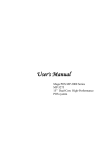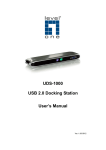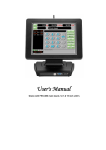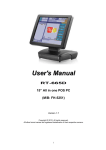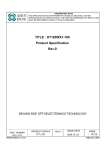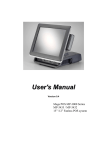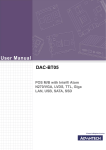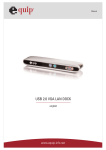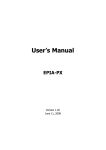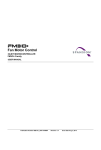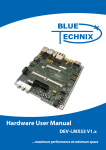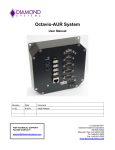Download User`s Manual
Transcript
User's Manual Glaive Pro RT-660C Series 12”/15” Fanless POS System Copyright Notice This document is copyrighted, © 2009. All rights are reserved. Firich Enterprise Co., Ltd has the right to make improvements of the product described in this manual at any time without notice. No part of this manual may be reproduced, copied, translated, or transmitted in any form or by any means without the prior written permission from Firich Enterprise Co., Ltd. Information provided in this manual is intended to be accurate and reliable. However, Firich Enterprise Co., Ltd assumes no responsibility for its use, nor for any infringements upon the rights of third parties, which may result from its use. The material in this document is for product information only and is subject to change without notice. While reasonable efforts have been made in the preparation of this document to assure its accuracy, Firich Enterprise Co., Ltd, assumes no liabilities resulting from errors or omissions in this document, or from the use of the information contained herein. Safety and Warranty 1. Read these safety instructions carefully. 2. Keep this user's manual for later reference. 3. Disconnect this equipment from any AC outlet before cleaning. Do not use liquid or spray detergents for cleaning. Use a damp cloth. 4. For pluggable equipment, the power outlet must be installed near the equipment and must be easily accessible. 5. Keep this equipment away from humidity. 6. Put this equipment on a reliable surface during installation. Dropping it or letting it fall could cause damage. 7. The openings on the enclosure are for air convection. Protect the equipment from overheating. DO NOT COVER THE OPENINGS. 8. Make sure the voltage of the power source is correct before connecting the equipment to the power outlet. 9. Position the power cord so that people cannot step on it. Do not place anything over the power cord. 10. All cautions and warnings on the equipment should be noted. 11. If the equipment is not used for a long time, disconnect it from the power source to avoid damage by transient over-voltage. 12. Never pour any liquid into an opening. This could cause fire or electrical shock. 13. Never open the equipment. For safety reasons, only qualified service personnel should open the equipment. 14. If any of the following situations arises, get the equipment checked by service personnel: a. The power cord or plug is damaged. b. Liquid has penetrated into the equipment. c. The equipment has been exposed to moisture. d. The equipment does not work well, or you cannot get it to work according to the users manual. e. The equipment has been dropped and damaged. f. The equipment has obvious signs of breakage. 15. DO NOT LEAVE THIS EQUIPMENT IN AN UNCONTROLLED ENVIRONMENT WHERE THE STORAGE TEMPERATURE IS BELOW -20° C (-4°F) OR A BOVE 60° C (140° F). IT MAY DAMAGE THE EQUIPMENT. Table of Content Chapter 1 Introduction 1 1 RT-660C Introduction........................................................................................................... 1 A Quick Tour of RT-660C .................................................................................................... 2 RT-660C Dimension ..................................................................................................... 3 Rear I/O Panel..................................................................................................................... 4 Packing List ......................................................................................................................... 4 Chapter 2 Hardware Installation and Upgrading 5 5 2.5” Hard Disk / SSD Drive Installation.......................................................................... 5 2nd Display Installation ................................................................................................. 6 M/B Box Maintenance................................................................................................... 6 Jumper Setting Adjustment & Memory Installation ........................................................ 7 VFD Customer Display Installation................................................................................ 8 MCR Parameter Modification ........................................................................................ 9 Cash Drawer Installation............................................................................................. 10 Chapter 3 Software Installation and Setup 11 11 Driver Installation ............................................................................................................... 11 Please follow this installation sequence. ............................................................................ 11 Intel Chipset Driver Installation .......................................................................................... 11 VGA Driver Installation....................................................................................................... 14 945GME driver installation for Windows XP................................................................ 14 LAN Driver Installation ....................................................................................................... 17 LAN Driver Installation for Windows XP ...................................................................... 17 Audio Driver Installation ..................................................................................................... 19 Audio Driver Installation for Windows XP .................................................................... 19 ELO Touch Tools Installation ............................................................................................. 21 ELO Touch Tools Installation for Windows XP ............................................................ 21 ELO Control Panel...................................................................................................... 26 TouchKit Tools Installation................................................................................................. 29 Fuji TouchKit Installation for Windows XP................................................................... 29 TouchKit Control Panel ............................................................................................... 33 Wireless LAN Driver Installation......................................................................................... 34 Chapter 4 Specifications 37 37 RT-660C Specifications ..................................................................................................... 37 I/O board Configuration...................................................................................................... 39 RG9000CB0880 I/O Board Pin Definition.................................................................... 39 Chapter 5 Troubleshooting 42 42 Power is on, but there is no Panel Display .................................................................. 42 Cannot Detect HDD .................................................................................................... 42 Touch Panel Does Not Work....................................................................................... 43 Touch Panel Cannot Calibrate Correctly ..................................................................... 43 MCR Is Not Functioning Properly................................................................................ 43 VFD Display Is Not Functioning Properly .................................................................... 44 LAN Is Not Functioning Properly ................................................................................. 44 COM1, COM2, COM5 & COM6 Are Not Functioning Properly .................................... 44 Cash Drawer Port Is Not Functioning Properly............................................................ 44 USB device is not functioning properly........................................................................ 44 Chapter 1 Introduction RT-660C Introduction RT-660C is a flagship system of FEC POS solution. The extensible, robust and fanless design makes it a perfect solution for retail and hospitality market. Fanless Solution w/ ATOM 1.6GHz CPU & 945GME Strong Graphic Performance Easy Installation for 2nd Display 12V DC Out for 2nd Display Connection w/o Extra Adaptor Required Easy Maintenance for M/B Box Easy Access to RAM and COM Port Jumpers for Pin 9 RI/5V/12V Selectable System w/2nd display System w/VFD 1 A Quick Tour of RT-660C Before you start, take a moment to become familiar with RT-660C. 2nd Display 1st Display Identification Device Power LED Identification Device HDD Location Power Button External I/O 2 RT-660C Dimension 3 Rear I/O Panel I/O Port Connector Type Description D-sub 25 Connector Connect a parallel printer or a LPT-type Key Pro device. D-sub 9 connector Connect serial devices such as a serial printer or a fax/modem. D-sub15 Connector Connect the monitor or 2nd display to the terminal 12V DC Out Connector Sustain the power of 2nd display Earphone Connector Connect the speakers to this port RJ11 Connector RJ45 Connector Connect cash drawer, 12V actuation support Connect RT-660C to the Ethernet USB Type A Connector Connect external USB devices RJ45 Connector with LED Indicators (5V/12V) Connect the VFD customer display or serve as an additional serial port (switching cable can be requested by order). (Green LED for 5V/ Orange LED for 12V/ None for RI.) DC Power Connector Connect the adaptor to RT-660C Packing List Optional: • RT-660C Terminal x 1 • 2nd LCD display (8.4”/12”/15”) • 150W Power Adapter x 1 • • Driver & Manual CD x 1 Identification Module (MSR/ RFID/ IC Card Reader/ Fingerprint Selectable) • AC Power Cord x 1 • VFD Customer Display • Wireless LAN Module • RAM Heatsink Module • 2nd DDRII SO-DIMM RAM (512MB/ 1GB / 2GB) • RJ45 to DB9 Switching Cable (for RAM height = 30mm type only) 4 Chapter 2 Hardware Installation and Upgrading Do not remove the rear cover until you have verified that no power is flowing within the system. Power must be switched off and the power cord must be unplugged. Every time you service the system, you should be aware of this. 2.5” Hard Disk / SSD Drive Installation 1. Turn off power and remove power cord from the system 2. Lay the LCD face down on a flat surface and remove the back cover of the 1st display by releasing 4 screws in the corners 3. Use the 4 screws provided to mount the HDD into the brackets and connect the SATA cable to the HDD. 4. Restore the back cover onto the 1st display. 5. Connect the power cord to the system Note: If the HDD does not work normally, please refer to troubleshooting 5 2nd Display Installation 1. Remove the plastic cover above the rear I/O panel 2. Slide in the 2nd display set and screw it on the system 3. Connect the VGA cable and power cable of 2nd display set to the rear I/O panel M/B Box Maintenance 1. Turn off the system power. 2. Remove the 6 screws and the M/B box can be detached from the terminal. 6 Jumper Setting Adjustment & Memory Installation 1. Turn off the system power. 2. Unscrew the cover and remove it from the base. Note: When RAM x 2 are applied, the upper RAM is recommended to be installed with the RAM heatsink module. 3. Restore the cover and fix the screw. 7 VFD Customer Display Installation 1. Turn off system power. 2. Make sure that JCOM4_SEL and JCOM4 jumpers on the M/B are set correctly. It is important to note that the supply voltage settings for all the COM ports are set to RI as default. If a VFD customer display is applied, please set the JCOM4 to +12V. Otherwise, when a LCD customer display is chosen, please set the voltage to +5V instead. 3. Remove the plastic cover above the back I/O panel 4. Slide in the VFD set and screw it on the system 5. Connect the VFD cable to Com4 port on the rear I/O panel Note: If the VFD does not display correctly after an application is loaded, please refer to troubleshooting. 8 MCR Parameter Modification This option is for users who need to customize the MCR configurations for a particular task. To enter the Configuration Mode, please execute text editor program (such as Microsoft Word, Notepad…etc.) first, and then press [Ctrl] + [Alt] + [F10]. The following menu will appear accordingly. For detailed instruction, please refer to the MSR212 Programmer’s Manual under the path below in the driver CD: \Utility\MCR\MCR util\Uniform\MSR212(Uniform) USER MANUAL(ENGLISH) 9 Cash Drawer Installation Before connecting the cash drawer to the RT-660C, please make sure the drive voltage and cable pin assignment of the cash drawer matches the definition of the cash drawer port of RT-660C. Please refer to the mother board manual GPIO part for more information. Plug cash drawer cable into the cash drawer port. Note: If the cash drawer cannot be detected by the system, please refer to troubleshooting. Up to two cash drawers may be driven from this port. Driving voltage of the solenoid is DC+12V. I/O port 2F is used for drawer operation. A test program is supplied, for Linux and Windows, source code of which is available on request by software developers. OPOS driver, test software and sample dll files can be found under the Utility folder in the system driver CD attached (DLL Library: Utilities\Cash Drawer\cashdrawerdll\ Test Program: \Utilities\Cash Drawer\cashdrawertest\) To test for drawer open, read port 2F, if bit 0=1 then drawer is open, if bit 0=0 drawer is closed. Before testing the cash drawer function, ensure to initiate the GPIO port first referring to the command sets below: initGPIO=2e,87,2e,87,2e,07,2f,07,2e,f1 ( 2e stands for the address while ‘87’, ‘07’, ‘f1’ stands for the value to the address. All the values here are hexadecimal.) 10 Chapter 3 Software Installation and Setup Driver Installation RT-660C comes with a variety of drivers for different operating systems. You will find the CD with RT-660C which has all necessary drivers for this system. Please follow this installation sequence. Driver installation sequence: Chipset Driver -> VGA Driver -> LAN Driver -> Audio Driver -> Touch Tools The reason to follow our sequence is that IRQ settings will be changed by Windows 2000 and XP to non supported values, and you may encounter unnecessary problems later. Intel Chipset Driver Installation 1. Insert the CD into your CD ROM Drive. 2. Locate the folder of D:\Driver\Chipset\XP2KVISTA 3. Open Setup.exe 4. Click Next. 11 5. Read the License Agreement and click Yes. 6. Click Next and the drivers for the Intel Chip set will install. 12 7. Please wait while the setup program processing. 8. When the 'Setup COMPLETE' message appears click Finish to restart your computer. 13 VGA Driver Installation 945GME driver installation for Windows XP 1. Locate the folder of D:\Driver\VGA\XP2K 2. Open winxp_14324.exe 1. Select Next to continue. 2. Select Next to continue. 14 3. Read the License Agreement and click Yes. 4. Click Next to see the setup progress. 15 5. Select Next to continue. 6. Click Finish to complete the installation procedure and restart the system. 16 LAN Driver Installation LAN Driver Installation for Windows XP 1. Locate D:\Driver\LAN\XP2K\ 2. Double click Setup.exe. 3. Click Next to continue 4. Click Next to continue 17 5. Please wait while processing. 6. Click Finish to complete the installation procedure. 18 Audio Driver Installation Audio Driver Installation for Windows XP 1. Locate D:\Driver\Audio\XP2K\ 2. Double click Setup.exe. 3. Click Next to continue. 4. Click Next to continue. 19 5. Click Finish and restart the system. 20 ELO Touch Tools Installation ELO Touch Tools Installation for Windows XP 1. Locate D:\Utility\Touch Screen\ELO Touch\XP_Vista 2. Open SW600650.exe 3. Click OK to continue. 4. Click Unzip to continue the installation. 5. Click OK to continue. 21 6. Pick the default language for the Elo Touchscreen and click Next to continue. 7. Check “Install serial Touchscreen Drivers” And click Next. 8. Read the “License Agreement” and click Yes if you accept it. 22 9. Select “Auto-detect Elo touchscreens” and click Next. 10. Select the COM port for the touch monitor. It is recommended that you select COM3 for the touch screen, as this port is internally configured for touch operation. And click Next to continue. 11. Make sure the COM port listed is the one you chose for your touch monitor. Press Next to continue. 23 12. Wait until the ELO Touch Tools installation finished. 13. Select “Calibrate ELO Touchscreen monitors” and click Finish. 14. Start calibrating the touchscreen by touch the targets showed on the screen. 24 15. If the cursor is working fine, click screen again. to finish the setting; if not, click to calibrate the IT MAY BE NECESSARY TO RESTART YOUR COMPUTER TO UTILIZE YOUR TOUCHSCREEN FEATURES. 16. Click Restart to reboot your computer again. 25 ELO Control Panel This section explains the different options in the ELO control Panel. General tab The general tab allows you to: • Change the COM port your touch screen is set to. • Calibrate the touch screen with the Align button. Mode tab The Buttons tab allows you to: • Adjust all mouse emulation controls. • Change cursor properties • Enable or disable right mouse button utility. 26 Sound tab The Sound tab allows you to: • To change sound properties for ELO touch tools. Properties tab The Diagnostics tab allows you to: • View Controller Information. 27 About tab The About tab displays Information about ELO Touch systems 28 TouchKit Tools Installation Fuji TouchKit Installation for Windows XP 1. Locate D:\Utility\TouchScreen\TouchKit(Fujitsu)\Windows 2000 XP\ 2. Select the relevant folder for the operating system that you are using. 3. Open Setup.exe 4. Click Next 5. Click Next 29 6. Click Next 7. Click OK to close the pop-up dialog. 8. Click “Support Multi-Monitor System” and then Next to continue. 30 9. Click Next 10. Click Next 31 11. Click Yes 12. Click OK and turn off the computer to restart your system again. After the system finish rebooting follow the directions to calibrate the Touch screen. 32 TouchKit Control Panel This section explains the different options in the TouchKit control Panel. General tab The general tab allows you to: • Manage the touch screen controller you installed. Tools tab The tools tab allows you to: • Calibrate the touch screen with the 4 Points Calibration button. 33 Wireless LAN Driver Installation 1. Locate D:\Utility\Wireless Lan\Ralink 2. Open RALINK(3.0.7.0).exe 3. Click “Next” and start the installation 4. Select “Ralink Configuration Tool” and click Next to continue. 34 5. Select “Optimize for WiFi mode” and click Next to continue. 6. Click Install to continue. 35 7. Wait while the installation is processing. 8. Click “Finish” to complete the installation. 36 Chapter 4 Specifications RT-660C Specifications System Configuration CPU (BGA) INTEL ATOM N270 (1.6GHz with 512K L2 cache) Chipset INTEL 945GME South Bridge INTEL ICH7-M Memory Two 200-pin SODIMM support DDRII SDRAM up to 4GB VGA controller GMA950 Integrated in 945GME, shares system memory up to 224MB Primary LCD Panel 12” /15” TFT LCD Panel (800X600/1024x768) Primary Touch Panel 12” with 4-wire or 15” with 4/5-wire resistive touch panel Storage Internal 2.5” SATA hard disk drive or 2.5” SATA SSD Power 150 watt external power adapter I/O Port Serial Port 5 User available COM ports (COM1 / 2 / 4 / 5 / 6) D-SUB9 (RS-232): COM1, COM2, COM5, COM6 RJ-45 (VFD or RS-232): COM4 for VFD or RS-232 device. (LED Indicators: Green for 5V / Orange for 12V / Non for RI) 1 System assigned COM port (COM3) COM3: for primary touch screen Parallel Port One Bi-directional Parallel Port supports ECP/EPP (IEEE1284). USB port 8 USB 2.0 ports (4*Internal, 4*External) 37 Cash drawer port RJ11 Cash drawer port,12V actuation. Controlled through GPIO port 2F LAN Port 10/100/1000Mbps Ethernet Controller, Realtek RTL8111C VGA Port Standard D-SUB 15PIN VGA Port for second LCD panel. Audio Port Integrated Sound Blaster compatible, AC97 Audio Codec. (Realtek ALC662) DC Out Port 2PIN 12V DC Out for 2nd Display Power Connection Optional Features Customer display Integrated VFD/LCD customer display MSR External Magnetic Stripe Card Reader track 1/2/3 Identification Device External Finger Print Receiver or RFID receiver(USB) Wireless Internal Wireless Module(USB) Power Consumption Power consumption 60W Idle (Standard system with secondary LCD panel while accessing HDD). Operating temperature Operating temperature 0 ℃ ~ 40 ℃ 38 I/O board Configuration The RG9000CB0880 board carries the following signals to the main board, including LVDS, inverter, COM3, Keyboard and two USB ports. RG9000CB0880 I/O Board Pin Definition JCS1 JCS1 Multi Signal connector PIN No. Description PIN No. Description 1 DSR3 23 +5V 2 3 4 5 6 7 8 9 10 11 12 TX3 RX3 RTS3 GND +5V Line Out L Line Out R GND GND Vin (+12V) Vin (+12V) 24 25 26 27 28 29 30 31 32 33 34 GND PC Clock KB Clock PC Data KB Data PVDD PVDD RX0+ RX0RX1+ RX1- 13 14 15 16 17 18 19 20 21 22 ON/OFF (+5V) GND Vcc GND USB DataUSB Data+ USB DataUSB Data+ GND Vcc 35 36 37 38 39 40 41 42 43 44 GND GND RX2+ RX2RX Clock+ RX ClockRX3+ RX3GND GND 39 MSR1 K/B Wedge MCR/USB connector PIN No. 1 2 3 4 5 6 7 8 USB1 Description USB Data+ GND PC DATA KB DATA PC Clock KB Clock VDD USB Data- USB connector PIN No. 1 2 3 4 Description VDD DATADATA+ GND INVERTER1 LCD Back Light connector PIN No. 1 2 3 4 5 LVDS1 Description DC+12V DC+12V Back Light Enable (+5V) GND GND LVDS connector PIN No. 1 2 3 4 5 6 7 8 9 10 Description PVDD PVDD GND GND RX0RX0+ GND RX1RX1+ GND PIN No. 11 12 13 14 15 16 17 18 19 20 40 Description RX2RX2+ GND RXCLKRXCLK+ GND RX3RX3+ GND GND TOUCH1 RS232 connector PIN No. 1 2 3 4 5 6 AUDIO1 DESCRIPTION GND TX RTX RS DSR +5V AUDIO connector PIN No. 1 2 3 4 DESCRIPTION Line Out R GND GND Line Out L 41 Chapter 5 Troubleshooting Please note that the following troubleshooting guide is designed for people with strong computer hardware knowledge such as System Administrators and Engineers. Power is on, but there is no Panel Display A) Check if the motherboard Power LED is on when the power adapter is connected properly. B) If the LCD backlight is on but no content showed on the screen, please make sure the SATA cable is properly connected to the HDD. C) Reset CMOS DATA by shorting motherboard JCMOS PIN2 and PIN3 for a few seconds (Please refer to page 10 in the FEB-9457 User’s Manual). D) Check if the system is beeping. D-1) A single long beep indicates that a DRAM error has occurred. Please make sure the DRAM is properly installed, or please replace the DRAM. D-2) One short beep after power on means the system works normally, but the LCD panel or LVDS interface could be defective. D-2-1) The Boot Display setting in COMS setup should be set to [CRT+LFP1]. D-2-2) LVDS board connection to motherboard LVDS1 could be defective.. D-2-3) The LCD cable could be defective. D-2-4) The Inverter is not working. D-2-5) The LCD panel could be defective. To check where the problem could be: Please connect a VGA monitor to the VGA port. If the VGA monitor displays normally, one of the problems above is occurring, otherwise the motherboard may not function properly. Cannot Detect HDD A) Check if the SATA cable is connected properly to the motherboard SATA Connector or it could be defective. B) Check CMOS setup, and set SATA HDD to [Auto]. C) On-board SATA port could be defective. 42 Touch Panel Does Not Work A) Check CMOS settings, COM3 needs to be “Enabled”. The correct settings are “3E8h” and “IRQ10”. B) Check if there are any conflicts between COM3 IRQ10 and other devices. C) Check if the ELO driver or the TouchKit driver has been properly installed. Or try to reinstall the driver (Please refer to the ELO driver installation or the TouchKit part). D) Check if the ELO controller or the TouchKit driver on COM3 has been detected during the ELO driver or the TouchKit driver installation. If yes, then check whether the flat cable from the ELO touch screen or the TOUCHKIT touch screen has been properly connected to the ELO controller or the TouchKit controller (Attention: Pin1 mark should be on the same side as the ELO controller). E) Check if the ELO controller or the TouchKit controller Green LED is blinking. If not, there is no DC+5V support for the ELO controller or the TouchKit controller from the motherboard. E-1) F) Check if the COM3 cable is properly connected between the motherboard and the Touch screen controller. Touch screen controller could be defective or the touch panel could be defective. Touch Panel Cannot Calibrate Correctly A) Please replace the touch controller, and re-calibrate. If this works, change back to the original touch controller, and re-calibrate. B) If the touch panel still cannot calibrate correctly after changing to a new touch controller, the touch panel may not be installed properly or it could be defective. MCR Is Not Functioning Properly A) Check if the green MCR LED is on. A-1) Check if the MCR is properly connected to the MCR connector board on main system. A-2) Make sure the MSR cable is properly connected between RG9000CB0880 I/O board MSR1 and the MCR connector board. A-3) The MCR connector board could be defective. A-4) The MCR module could be defective. 43 VFD Display Is Not Functioning Properly A) Ensure that COM4 is set to [Enabled] in the CMOS setup, and data is written to COM4 in the application. B) Check if there is any display when system power is on. If the screen is blank, please follow the steps below. B-1) Make sure the power switch on the VFD display is on before powering the main system. B-2) Make sure the motherboard JCOM4_SEL & JCOM4 jumper settings are correct. The proper settings are: JCOM4: Pins 5-6 shorted (+12V) JCOM4_SEL: Pins 1-2, Pins 3-5 and Pins 4-6 shorted (VFD Mode) C) The on-board COM4 I/O chips could be defective. LAN Is Not Functioning Properly A) Check if the LAN driver is installed properly. (Please refer to the LAN driver installation) B) Check if there are any IP Address conflicts. C) Check if the RJ45 cable is properly connected. D) The on board LAN chip could be defective. COM1, COM2, COM5 & COM6 Are Not Functioning Properly A) Check if the I/O ports are enabled in the CMOS setup. B) Check if there are any IRQ conflicts. C) The motherboard could be defective. Cash Drawer Port Is Not Functioning Properly A) Make sure the pin assignment matches between the cash drawer and the RJ11 cash drawer port. B) Verify the GPIO port address and the bit is “2F”. Check other details from the system manual page 10 and FEB-9457 User’s Manual page 50. C) The motherboard could be defective. USB device is not functioning properly A) Ensure that the USB controller is “enabled” in the CMOS setup. B) Ensure that the USB Legacy is “enabled” in the CMOS setup. (Windows 98、Windows 2000、Window XP Professional) C) Ensure that the USB Legacy is “Disabled” in the CMOS setup. (Embedded OS: Windows XP Embedded、Window CE. NET、Linux RedHat 9) 44


















































